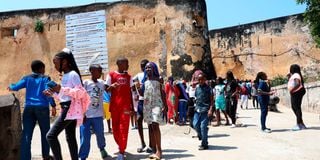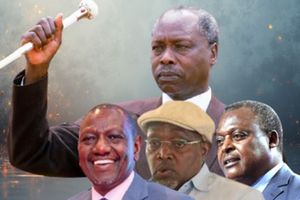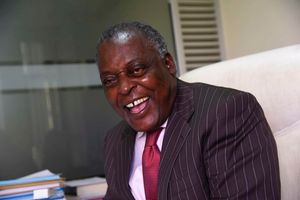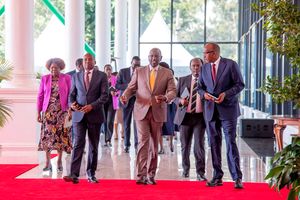Premium
The Ogots’sweeping history of Mombasa

School Children on holiday at the Fort Jesus Monument in Mombasa on August 16, 2023. Mombasa Tourists sites have continued to experience huge number of Visitors during the August School Holiday.
Kenyans from upcountry are raised to believe the ultimate holiday is to be spent in Mombasa. Or that travelling to the Coastal city is a dream one has to live.
The old saying goes that it is easy to arrive in Mombasa but hard to depart. Fables of young Kenyans who left their countryside homes to visit Mombasa but never returned abound. Some return when they are old; others in caskets.
Watu wa Bara, as upcountry Kenyans are referred to, probably get mesmeriSed by the Ocean and the slow-paced but certain rhythm of life in the city.
But the real seduction for the upcountry folks is in the “potential” to make money at the port. Loading and unloading cargo presents imaginary opportunities for newly employed people.
Port cities are zones of smuggling. Contraband is available in plenty. Goods that arrive on the ships present unimagined opportunities for money-making.
It is not surprising to hear stories of a young man who left his village just with the clothes on his back but recently returned home with limitless money.
Young women dream of meeting a mzungu, who will give her a dream life, either in Mombasa or fly with her to Europe. The ship (or the plane these days) has always been a carrier or bringer of unknown goods or luck for she or he that the stars in heaven or the spirits of the ocean favour.
Mombasa is the latest city – after Kisumu and Nairobi – that Bethwel Ogot and Madara Ogot pay homage to in their book, Mvita: History of Mombasa 12th Century – 2012 (Anyange Press, 2023).
This is not only the latest book on Mombasa but also the most authoritative.
Writing about the origins of Mombasa, the Ogots restate the significance of the Swahili. These communities formed the earliest settlements on the Coast. But Mombasa was was connected to other major settlements like Malindi and Zanzibar, which meant that it had a heavy influence from the Arab world, as reflected in the role of and rule by the Shirazis and Mazruis. This is why the politics, cultures, religions and economics of Mombasa partly are tied to those of the Gulf.
It is surprising how one hardly senses, whilst in Mombasa, that it was once a colony of Zanzibar.
Yet, to speak of Mombasa is to talk about the mix of people who have not just ruled the city but also left a significant cultural imprint on its life.
Mombasa has a heavy Arabic influence as can be seen in the mosques, dressing, food, architecture etc. But it is also a city of the Miji Kenda, local communities that have bequeathed it cuisine, language, culture etc.
The politics of Mombasa revolves around the stakes the descendants of the three core communities that settled in the city – the Swahili, Arabs and Miji Kenda – have.
Why the title Mvita? Because Mombasa was once mji wa vita, the city of war. The Arabs once ruled Mombasa. The Portuguese ruled Mvita. The British colonised the city. Today, these former rulers have a stake in the city. Some are landowners – one of the most contentious issues in Mvita. Others own businesses such as shipping, export and import, connecting Mombasa to the rest of the world. The hotel and tourism sector illustrates how Mombasa remains part of a global network of business.
There are tens of hotels associated with investors from particular parts of the world – Germans, Americans, Italians or moneymen from the Gulf. Indeed, some hotels offer visitors a little bit of the cultures and cuisines of the countries of their owners.
That history of Mombasa remains relevant for many reasons. First, the survival of Mombasa demonstrates its resilience. Its people, especially the Swahili and Miji Kenda, have endured foreign domination, some of it violent, others benevolent and lived to tell the stories.
Fort Jesus, for instance, is celebrated as a big part of Mombasa’s heritage. Yet, it is a symbol of Portuguese rule; a rule that wasn’t kind to locals. The city may have had its share of politically-motivated and gang violence, but it is not for nothing that it is referred to in popular parlance as Mombasa raha – city of happiness. Mombasa people tend to be more welcoming to visitors than Kenyans in other parts of the country.
Second, the city remains key to trade in East Africa. Through its port – and Malindi – goods arrive from different parts of the world destined to Kenya’s neighbours. Mombasa supplies much of Eastern Africa with oil, medicine, houseware, cement, salt, cars, furniture etc. Even though Dar es Salaam is on the rise, Mombasa is still the port of reference in the East African Community.
It has the name recognition, knowledge and skills to do with delivery of goods. A dysfunctional port of Mombasa would peril economic life in many parts of Eastern Africa.A working port is key to the development and prosperity of Eastern Africa.
Third, Mombasa has hosted Persians, the Chinese, Arabs, Europeans; foreigners and travellers from all over the world for centuries. These visitors have been its ambassadors to the rest of the world. They keep the story of Mombasa alive in the rest of the world. They arrive as tourists, traders, adventurers (watersport and deep water sport fishing, for instance), visiting families and friends (connections between Mombasa, India and the Gulf states have been going on for millennia), and carry with them back home stories from the city.
Yet, the most significant promoters of Mombasa are local visitors who are wowed by the politeness of their hosts, the musicality of the Mombasa Kiswahili (also known as Kimvita), the coolness of the seawater in the sweltering heat, the madafu etc.
When the visiting Kenyans return home, they carry with them the myths of the city and inspire many others to visit Mombasa.
Yet, it is possible to arrive in Mombasa, enjoy the hospitality and depart without knowing much about its history. Which is why Mvita is worth reading.
It will reveal to the reader how the city was planned, the history of some of its architecture, the mix of races and religions, the significance of some political figures and the city’s understated connection to the rest of the world. One hopes Mvita will provoke Kenyans to write more about the city’s politics, economics, culture, religions, tourism etc.
- Dr Odhiambo is a senior lecturere in the Department of Literature, the University of Nairobi.





